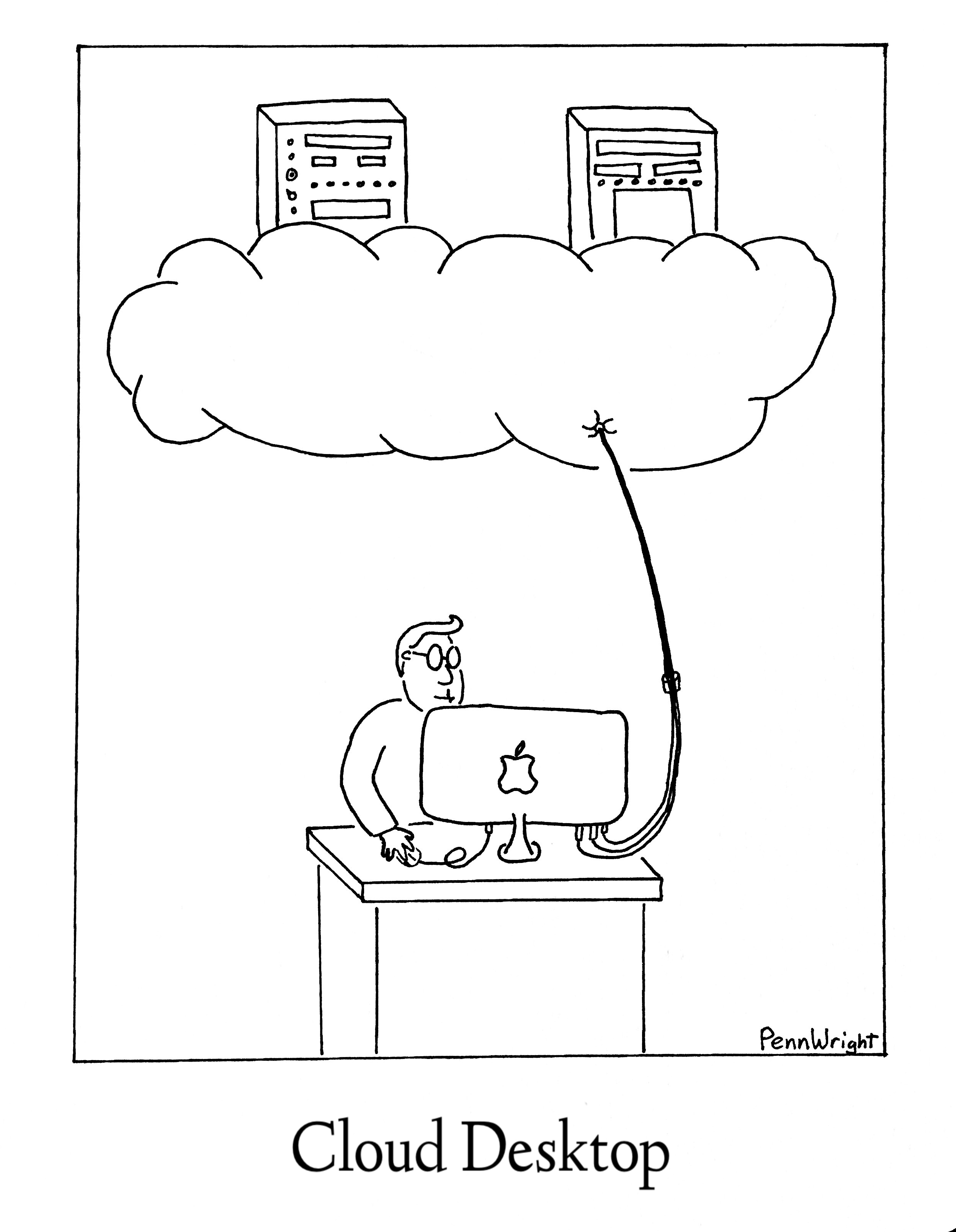Perhaps the most frustrating part about owning technology is needing to upgrade that technology every four or five years. Many of us dread the process of transitioning old files to a new device. Not to mention, the learning curve associated with it. But, an emerging solution is Cloud Desktops (computers in the cloud).
The Problem with Computing
There are three things we care about as computer users: Speed, Security, and Software. To illustrate my point, let’s pretend you just bought a new iMac computer.
The speed of that device will always be limited by the processor, RAM, and hard drive that was installed. Once a new iMac comes out, the only way to increase your current computer’s speed is to buy a new iMac or deal with the arduous process of taking apart your machine, voiding the warranty, and installing new components yourself.
Similarly, the security of your iMac is solely at your discretion. It’s your job to do security checks with AntiVirus software. To beef up security, you must regularly install new operating system updates. You might go years without knowing that developers have updated the applications and software on your computer. Then if something goes horribly wrong, you’ll need a computer technician to help you out.
Take the recent Meltdown and Spectre computer hacks, which compromised the security of most computers allowing hackers to access information they should not be able to – like secret keys, passwords, or any other type of data owned by users. Unless you’re actively checking on the security of your computer, you wouldn’t know to protect yourself from this.
Your physical desktop computer requires a level of conscious thought and expertise that most of us just don’t care to have. But, it’s important that we improve the speed, security, and software of our computers so that we don’t fall behind. It’s just like owning a car. The more care you take to make sure everything runs smoothly, the longer that car is going to run.
Outlining the Virtual Desktop Infrastructure
With Cloud Desktops, all three of those attributes – speed, security, and software – can be managed by a centralized entity, ensuring that your computing capabilities are top-notch and secure at all times. It’s like a party planner taking care of all the planning and grunt work so you can enjoy your birthday party without any stress. Sounds pretty nice, right?
Paperspace, VMWare, Citrix, and Amazon Workspaces are some of the dominant players in the Cloud Desktops space – providing early-adopters with the option of a more secure and faster computing alternative.
The very basic premise of Virtual Desktop Infrastructure is that instead of worrying about upgrading your iMac every few years, you simply pay a monthly fee (like Netflix) to have access to the latest and greatest computing hardware.
All you need is an internet connection, a web browser, and an account through their Virtual Desktop Infrastructure. An account that falls in the range of $30-40 / month would be just like the average price of buying a new computer every 5-6 years.
Companies like Paperspace and Amazon Workspaces will seamlessly improve the speed, security, and software of ALL users by improving their 5-10 on-site servers. Kind of like having a super-spatula that flips forty burgers at a time.
I’m sure you’re thinking, “Well, there’s really nothing wrong with my current setup. I don’t need to have the best machine. Cloud Desktops aren’t for me.”
And you’d be partially right.
Leasing Your Computer
Cloud Desktops are optimal for anyone needing a lot of computing power, such as engineers that create 3D CAD images, creative professionals that must edit a lot of photo and video content, machine learning experts training neural networks, and pro gamers.
But, that’s just who it appeals to right now.
In many ways, the debate for using Cloud Desktops seems like the difference between owning and leasing a car.
Owning a car, on the other hand, locks you down to that car for an extended period of time. Yes, you own that car and have the freedom to do with it as you please. Which also means the responsibility lies solely in your hands – no one is there to remind you to maintain your vehicle.
On the other hands, leasing a car allows you to upgrade your driving experience frequently. The dealership helps make sure you take good care of the vehicle by offering routine maintenance. And you never have to worry about selling your old car when it’s time to get a new one.
Cloud Desktops are like an advanced version of leasing cars, where you get access to a faster, safer, and smoother ride at all times (speed, security, and software). Imagine ten years from now if your 2016 Jeep Grand Cherokee ran just like the 2026 Jeep Grand Cherokee. It’s the same idea for your computer.
As the price for Virtual Desktop Infrastructure begins to get more competitive and the attributes start to become more apparent, there’s no reason that a majority of the population shouldn’t make the change.

The Mobility of Cloud Desktops
Perhaps the biggest advantage to running on Cloud Desktops is mobility. Anywhere in the world with an internet connection strong enough to stream Netflix is capable of running your Virtual Desktop Infrastructure. Which is a Catch 22, considering business execs that needs to work on airplanes or someone working in an area with spotty wifi will struggle to access their Virtual Desktop Infrastructure.
One solution is cyber-cafes – places where you pay for access to a public computer. Here in the US, we don’t see many cyber-cafes. But, abroad they are extremely popular, especially in Asia.
In Tokyo, cyber-cafes scattered across the city provide citizens with some of the most advanced computers available to the public. In Taiwan, cyber-cafes compete for users by acting like country clubs with amenities (free ice cream).
Cyber-cafes show us that the idea of actually owning your computer is cryptic, out-of-date. Instead, a company like Paperspace could provide cyber-cafes across a city, so that their Cloud Desktop users can compute anywhere at anytime.
In the US, Universities and schools actually foreshadow this future. In Madison, the university provides students with thousands of computers across dozens of library computer labs. Literally, wherever you are on campus you can access one of these remote workstations.
Imagine this across your entire city, open to the public. Instead of lugging your laptop to Starbucks, you could grab a coffee and pop over to a cyber-cafe. Heck, you might even just grab a gourmet coffee from the cyber-cafe.
Not only does this provide an opportunity for people to franchise cyber-cafes (just like a 7-11), but it would also drastically drop the number of computers we toss into landfills every year – lessening our Technofossil footprint.
Cloud Desktops enable us to advance our computing without the need for massive industrial production.
Sharing is Caring
Environmentally, we are realizing the impact of industrial production on our planet’s resources and climate. And while the obvious ointment is to stop buying so much stuff, ending consumerism is a pretty complex undertaking.
Which is why a more acceptable solution is the sharing economy. We are finding ways to create services that promote sharing instead of sole-ownership (i.e. sharing your car when you aren’t using it, opening your door for strangers to live in, etc…).
The sharing economy is about creating a third of the goods that can service three times the population. Allowing us to be easier on the planet and our pockets.
Let’s continue to retrace our steps to lessons learned in Kindergarten: Sharing is Caring.
Thanks for tuning into this week’s Quick Theories. Shoot me an email your thoughts on Cloud Desktops.



Hey this was super interesting, keep up the good work! Your friend, Ilkka
Good article on an interesting technology. Part of the problem with cloud desktops is that you still need a computer to access one. It’s like having to own a Toyota in order to lease a Mercedes. On top of that, I don’t trust the model of storing my most important files on a cloud desktop for a multitude of reasons. Perhaps there is a middle ground somewhere.
Really interesting post and food for thought. Lot’s of very cool applications of this for businesses too. But i already carry an internet connect and web browser in my smartphone. I think using it is would be a great option. What I don’t have is a really comfortable interface to actually do work things like a desktop keyboard, monitor, etc. Now I can connect a bluetooth keyboard to my smart phone and probably stream the display but these solutions are pretty raw. There is another distasteful aspect of the “public/shared” hardware and that is security. I’m less concerned about storing encrypted files in the cloud as I am keyloggers and the like on the shared hardware. But being over 40, I’m stuck with the need for old types of interactions with a desktop computer (keyboard, mouse/trackpad, dual monitor). I don’t think a lot of young people are so the space is open for new ideas and ways of working.
Interesting post. It seems to me that in 2020 the choice is made in favor of cloud services, and not modernization of the home PC. Basically, I need a laptop with a high-quality screen, a powerful processor and enough RAM. GPU is completely unnecessary now if you are not a gamer;) Cloud GPU services like Paperspace, AWS or https://puzl.ee/gpu-cloud cover my ML and rendering needs
Had you heard that contact form messages like these are in effect a great way to get more web traffic, sales, video views etc. for your online or offline business? How can we do it? Super easy, we create an advertisement like the one you’re reading now for your site and we submit it to thousands contact forms on any site in any business niche or location you like. Do ads like these work well? Well you’re reading this now aren’t you? What’s more, this won’t cost you much more than $3 a day! Want to get more info? drop us a line vie email here: UlisesMelinav85668@gmail.com